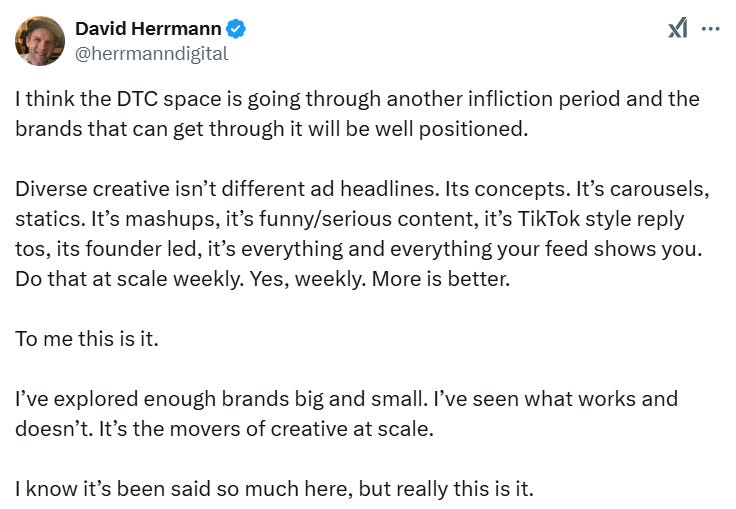The Vanity Metrics Trap
📉 When Engagement Becomes a False Signal, Perplexity AI Integrates DeepSeek AI Model, and more!
Howdy Readers 🥰
In this newsletter, you’ll find:
📉 The Vanity Metrics Trap: When Engagement Becomes a False Signal
🧠 Perplexity AI Integrates DeepSeek AI Model
🚀 Tweet of the Day
If you’re new to Buyology then a hearty welcome to you, You’ve reached the right place alongside 50k+ amazing people, Before you forget, if someone forwarded this newsletter to you, don't forget to subscribe to our newsletter so you never miss out!
Together with Insense
Find your perfect niche influencers within 48 hours
Fact: Nailin' that creator-brand alignment is the secret to high-performing UGC and influencer partnerships
Problem: Manually sifting through thousands of creators to find the perfect match is a time-consuming nightmare.
Solution: Insense.
You need Insense’s carefully vetted marketplace of 60,000+ UGC creators and micro-influencers from 20+ countries across the USA, Canada, APAC, and Latin America.
Dermatologists for your skincare brand? They’ve got it! Watch collectors? LGBTQ+ creators? They’ve got it!
2,000+ e-com, DTC, and Amazon brands are using Insense to find their perfect niche creators and run diverse collaborations from product seeding and gifting to TikTok Shop and affiliate campaigns, and whitelisted ads.
Quip - received an 85% influencer activation rate (32/37 influencers posted)
Any Age Activewear - quickly matched with mature female creators aged 50+ which boosted AOV by 20%
Try Insense yourself!
Book a discovery call by February 14 and get a $200 bonus for your first campaign.
📉 The Vanity Metrics Trap: When Engagement Becomes a False Signal
A TikTok goes viral, an Instagram post racks up thousands of likes, and the comment section is buzzing. It looks like a huge win—until you check sales. Crickets. The brutal reality? Engagement without buying intent is just noise.
While social media rewards visibility, visibility without conversions burns marketing dollars and creates a false sense of success. To scale profitably, DTC brands need strategic engagement—not just more of it.
🔥 Use “Purchase-Priming” Engagement Instead of Broad Reach
Most brands celebrate high engagement, but what matters is who is engaging. Instead of chasing general reach, trigger high-intent micro-actions. Example: Instead of asking users to “like if they agree,” prompt “DM us ‘YES’ to unlock a secret offer.” This instantly filters passive scrollers from potential buyers, creating a self-segmenting audience for retargeting.
🚀 Train the Algorithm to Prioritize Buyers, Not Lurkers
Your social engagement is training the platform’s AI on what audience to show your content to. If your viral posts attract non-buyers, the algorithm starts favoring the wrong people. Fix this by running engagement ads targeting past buyers and high-LTV customers. Every piece of viral content should be seeded to an audience that actually converts.
💬 Force Engagement to Work for You With Reverse CTA Strategies
Instead of passively waiting for engagement to turn into sales, make engagement an entry point for purchase intent. Example: Instead of linking to a website, brands like OLIPOP use comment-triggered DMs to move users directly into Messenger flows.
“Comment ‘GUTHEALTH’ below, and we’ll DM you an exclusive code.” This moves engagement from the public feed to a one-on-one conversion opportunity.
🎯 Engineer Intent-Driven UGC That Funnels to Sales
Most UGC boosts engagement but doesn’t guide users to buy. The fix? Pre-sell the product inside the content.
Instead of general lifestyle shots, create UGC that mimics the “consideration stage”—unboxings that answer doubts, influencer content that directly calls out why they chose your brand over others, or a “Try It vs. Skip It” format that builds trust. The best UGC isn’t just engaging—it’s a direct response ad in disguise.
Conclusion
Engagement shouldn’t be the goal—it should be a mechanism to filter, qualify, and convert. The smartest brands don’t just get attention; they engineer it to drive action. Because at the end of the day, likes don’t pay the bills—but strategic engagement does.
🧠 Perplexity AI Integrates DeepSeek AI Model
Insights from SEJ
Perplexity AI has introduced the Chinese DeepSeek R1 reasoning model for its Pro users, offering a new self-hosted AI option. While this expands its AI capabilities, the move has sparked controversy over censorship and data privacy concerns.
The Breakdown:
DeepSeek R1 Joins Perplexity Pro: Users can now choose DeepSeek R1 alongside models like OpenAI o1 and Claude 3.5, with hosting restricted to U.S. and European data centers.
Censorship Concerns Addressed – While the original DeepSeek R1 model includes censorship typical of Chinese AI, Perplexity CEO Aravind Srinivas confirmed that their hosted version is uncensored, as demonstrated in public tests.
Misconceptions About Data Security – Some users speculated that Perplexity’s integration could allow Chinese government oversight, but as an open-source, self-hosted model, all data processing remains within Perplexity’s infrastructure.
Perplexity’s adoption of DeepSeek R1 fuels debates over AI governance, censorship, and open-source AI’s future. While it broadens access to competitive AI models, it also highlights concerns about political influence in training data.
🚀 Tweet of the Day
Advertise with Us
Wanna put out your message in front of over 50,000 best marketers and decision makers?
Checkout our Partner Kit here🤝
At Buyology, we care about our readers and want to provide the best possible experience. That's why we always look for ways to improve our content and connect with our audience. It would be amazing if you could hit us up with feedback about our content or absolutely anything, we are always up for a chat 🥰
Thanks for your support, We'll be back with more such content 🥳



